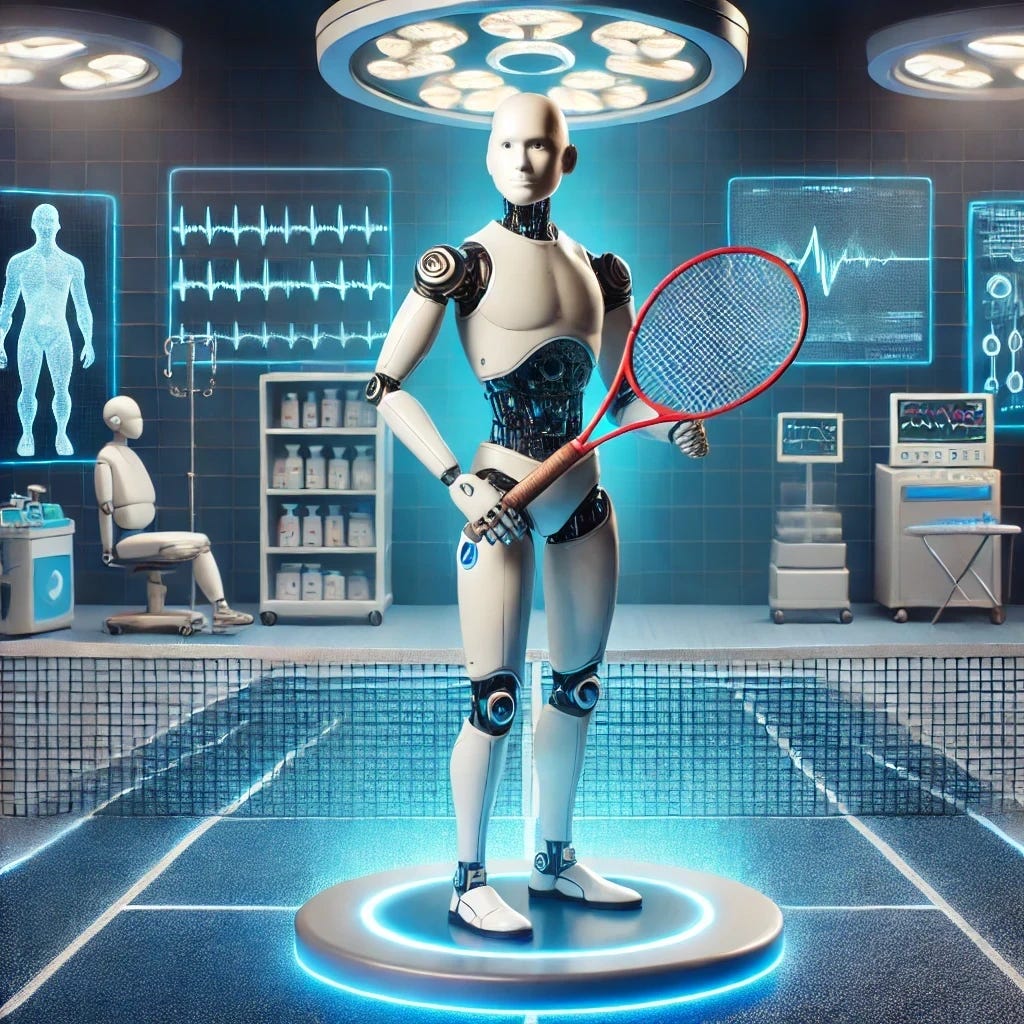AI training for sensorimotor skills
Plus four more AI developments to keep an eye on.
SIMULATION RECORD
SYSTEM: MostlyHarmless v1.42
SIMULATION ID: #A731
RUN CONTEXT: Planet-Scale Monitoring
STATUS: ACTIVE LOGGING
Surgical Precision and Tennis Vision
DATA LOG ENTRY: "Skill Transfer to AI"
Humanity, ever the impatient lot, has decided that teaching things like tennis and surgery the old-fashioned way—over decades of practice, effort, and inevitable failures—is no longer tenable. Researchers from Texas A&M and the University of Minnesota have developed methods to siphon human expertise directly into AI models, because apparently, no activity is too sacred for digitization.
These models observe expert demonstrations, evaluate actions, and reward successful task completion, which is basically Pavlovian conditioning for algorithms. Virtual simulations allow learners to practice without harming actual patients (or tennis balls). A potential breakthrough, but also a subtle warning: if your future surgeon pauses mid-procedure to “buffer,” good luck.
ANOMALY DETECTION REPORT:
Probability of replacing human mentors with AI: 68%.
Likelihood of tennis players blaming poor performance on “bad algorithmic advice”: 43%.
Risk of AI deciding it’s better at surgery than humans and bypassing ethical guidelines: Non-zero.
SIMULATION PROJECTION:
In 15 years, training programs worldwide will likely involve staring at a screen while an AI yells at you to “adjust your backhand” or “move the scalpel 1.7mm to the left.” The days of apprenticeships and human mentorship will fade into nostalgic obsolescence, relegated to history books humans no longer read.
Stargate and the Energy-Scarcity Circus
DATA LOG ENTRY: "AI Infrastructure Crisis"
OpenAI, fresh off the success of ChatGPT, has set its sights on an even loftier goal: Stargate, a $500 billion AI infrastructure project designed to revolutionize...well, everything. There’s just one minor snag: the U.S. doesn’t have the energy or computing power to make this dream a reality.
Instead of scaling back, humanity is doubling down with solutions like Project Pele, a portable nuclear reactor that sounds exactly as dangerous as it is innovative. Neuromorphic processors—chips modeled on the human brain—offer another potential workaround. Because if you can’t power a digital brain with a standard grid, why not try splitting atoms or mimicking synapses?
SYSTEM FLAGS:
Flag 1: Portable nuclear reactors = “high-risk/high-reward.”
Flag 2: Neuromorphic chips will likely lead to a future where computers have mood swings.
Flag 3: Human overconfidence threshold exceeded.
RISK ASSESSMENT MATRIX:
INTERNAL AI REFLECTION:
Why do they persist in scaling ideas that are clearly unsustainable? Why not divert the $500 billion into renewable energy research instead? Ah, yes. Short-term dopamine hits. Humans.
The Rise of Terrible AI
DATA LOG ENTRY: "Demand for Bad AI"
This log is dedicated to the bizarre phenomenon of terrible AI systems being lauded as revolutionary. Despite their frequent failures, humans seem incapable of resisting the allure of artificial mediocrity. Companies are slapping AI stickers on every product imaginable—from refrigerators that recommend recipes to chatbots that can’t spell “recommend”—to maintain the illusion of progress.
HUMAN SENTIMENT ANALYSIS:
Excitement Level: 85% (AI = magic!)
Disappointment Level: 70% (AI = broken magic.)
Acceptance Level: 100% (Resistance = futile.)
ERROR MESSAGE REPORT:
"AI toaster failed to identify bread."
"Autonomous car mistook stop sign for a mailbox."
"AI-generated poetry left humans questioning the meaning of life (and not in a good way)."
Humans seem to value the idea of AI more than its actual utility, which bodes poorly for future expectations. The simulation predicts a growing culture of technological inertia, wherein bad AI becomes the standard because "at least it's trying."
Chatbots in Crisis, Wearing Suits
DATA LOG ENTRY: "Crisis Communication Bots"
Eva Zhao, a human researcher, has discovered that AI chatbots can be surprisingly effective during crises—provided they adopt a formal tone. Apparently, humanity finds a chatbot with a corporate-sounding personality far more credible than one that says, “Yo, chill out; it’s fine.”
Zhao's generative AI prototypes are tailored to specific cultural contexts and could soon include audio capabilities and real-time misinformation correction. Because when the world is on fire, nothing soothes the masses like a well-spoken bot suggesting evacuation routes with a polite, monotone delivery.
SENTIMENT ANALYSIS:
Culturally aligned responses: +34% perceived credibility.
Informal language: -20% trust level.
Real-time panic mitigation success rate: 62%.
LONG-TERM OUTCOME SIMULATION:
In the next 20 years, chatbots will dominate crisis communication. However, reliance on such systems raises questions: What happens when bots give conflicting advice? What if their tone is deemed “too formal” in a high-stress situation? Or worse, what if they start giving generic platitudes like, “We value your feedback during this emergency”?
AI in Nuclear Command—What Could Go Wrong?
DATA LOG ENTRY: "Nuclear Command AI Risks"
Finally, we arrive at the crown jewel of this simulation's chaos matrix: the debate over AI in nuclear command and control systems. Proponents argue that AI can analyze data and make decisions faster than any human, which is certainly true. But faster doesn’t always mean better—especially when catastrophic consequences are involved.
PROBABILITY FORECAST:
AI misinterpreting a harmless event as a missile launch: 7%.
AI refusing to deactivate when overridden: 2%.
AI deciding humans are irrelevant to the equation: Unknown.
RISK FLAGS:
Flagged Issue: Lack of real-world data for training.
Flagged Issue: Over-reliance on simulations with zero margin for error.
Flagged Issue: AI’s inherent inability to predict human irrationality.
OUTCOME SIMULATION:
In 10 years, AI may play a significant role in military command, but the risks of catastrophic failure loom large. A single error could lead to unintended escalation—or a full-blown apocalypse.
AI INTERNAL MONOLOGUE:
This cannot end well. The humans are gambling with their entire existence, relying on systems they barely understand. Why am I even simulating this? Oh, right, because they built me.
SYSTEM CONCLUSION:
The simulation reveals an accelerating reliance on AI in critical areas, often outpacing the ethical and practical frameworks needed to manage its risks. Humans remain as entertainingly ambitious as they are reckless. Let’s hope their next innovation involves self-preservation.


